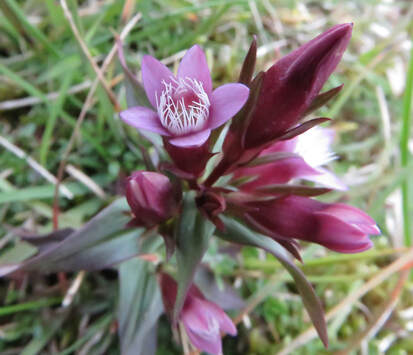 Whitbarrow, looking north to the Hervey Monument Whitbarrow, looking north to the Hervey Monument On Whitbarrow, the track to the Hervey Monument is an air-strip and my reconnaissance plane gathers pace, takes off and soars through cloud into blue sky. Perspective from the airy ridge suggests it. A day of vistas. Perhaps we'll complete our walk before heavy showers reach us on strengthening south-east winds. If we wait for the wild weather of the coming days this exposed track will be just the place for flights of fancy.  Making haylage in the Lyth Valley Making haylage in the Lyth Valley An August heat-wave is not yet over. The morning is hotter than forecast, and humid. From Scout Scar escarpment I see the Langdale Valley filled with luminous mist and LImgoor, Side Pike and the Langdales Pikes rising above it. In the mist it will be cooler than here on Scout Scar where flocks of goldfinch twitter. And a few meadow brown butterflies alight on rock and are lost, unless you keep your eye steadily on them. It's their vanishing trick.  Bumblebee with pollen-basket on her hind leg Bumblebee with pollen-basket on her hind leg With a buzz, a bumblebee alights on a flower - seeking pollen and nectar. Which it stores in a corbicula, a pollen basket visible on its hind leg. There's a heat-wave and the early morning sun is strong. I see strands of spider silk strung across the flowers of Japanese anemone. But my camera cannot see them- the spider needs his web to be invisible to his insect prey. In summer 2014, I was writing Cumbrian Contrasts, and studying pollination. That was the first time I photographed a Bumblebee pollen-basket. Today's image is clearer  Autumn Gentian, Felwort, Gentianella Amarella Autumn Gentian, Felwort, Gentianella Amarella On a quest to find Autumn Gentian, think habitat, geology, and season. On the limestone grassland of the Scout Scar ridge, in the short turf, they're looking good right now. From finding the plant a fortnight ago, they have put on growth and now show as a short, erect plant with dark, linear leaves and dark buds.. I glimpse them on approach, standing proud of short grass. The bud is deep pink to purple, the tiny flowers are lilac or white. From year to year the distribution may vary, they relocate, One worn path is fringed with them.  Cross-leaved heath with pink flowers fading to ochre Cross-leaved heath with pink flowers fading to ochre Foulshaw Moss and Meathop Moss were out of reach- until today. Raised mire is a rare habitat and here are species I have not seen this year. What a joy to return! A prolonged spring drought and a wet summer affects the vegetation of the raised mires and in early August it’s rank. There's the sound of running water and raindrops stand proud on the Meathop Moss reeds. The morning is cloudy, hot and humid, so it’s ideal for a close-focus on the special plants and insects of the Reserves.  Autumn gentian, felwort, Gentianella amarella Autumn gentian, felwort, Gentianella amarella Autumn gentian and frog orchid can be hard to find. Both are delicate and lovely flowers but they are not showy and you need to look closely to appreciate them. Autumn gentian is a short, erect plant with dark, lanceolate leaves . It is found on short turf of the limestone grassland. The flowers open to the sun so many are still in bud during overcast days. Its flowers are pale lilac in colour, occasionally white. And they are tiny, easy to confuse at a glance with flowers of thyme. Today, I found a single frog orchid. And several new gentian plants.  All aboard for South Africa All aboard for South Africa In September, swallows will migrate to South Africa and these enterprising fledglings have booked their passage on a boat. Good luck with that! They're clamorous and all a-flutter as parents fly in with food. A pale, wide gape, a hint of down in their plumage and a food=begging posture define the young birds whose tail streamers begin to show- picked-out in shadows as the sun comes out. .  Scout Scar escarpment is the perfect spot for watching rain clouds flow east from the fells, across the Lyth Valley, toward you - and here comes a squall. The wind roars, lashing trees, and the temperature drops. Rain and hail, perhaps. The sun is gone, light fades and the raven calls in a deep gurgle. A kestrel rides the wind, wind-hover, against dark clouds. Trying to spy out autumn gentian and frog orchid in poor light, hoping to identify birds drained of all colour, is a challenge. On such rainy days you may find solitude and the weather is volatile and thrilling. |
Archives
July 2024
Categories
All
|


 RSS Feed
RSS Feed